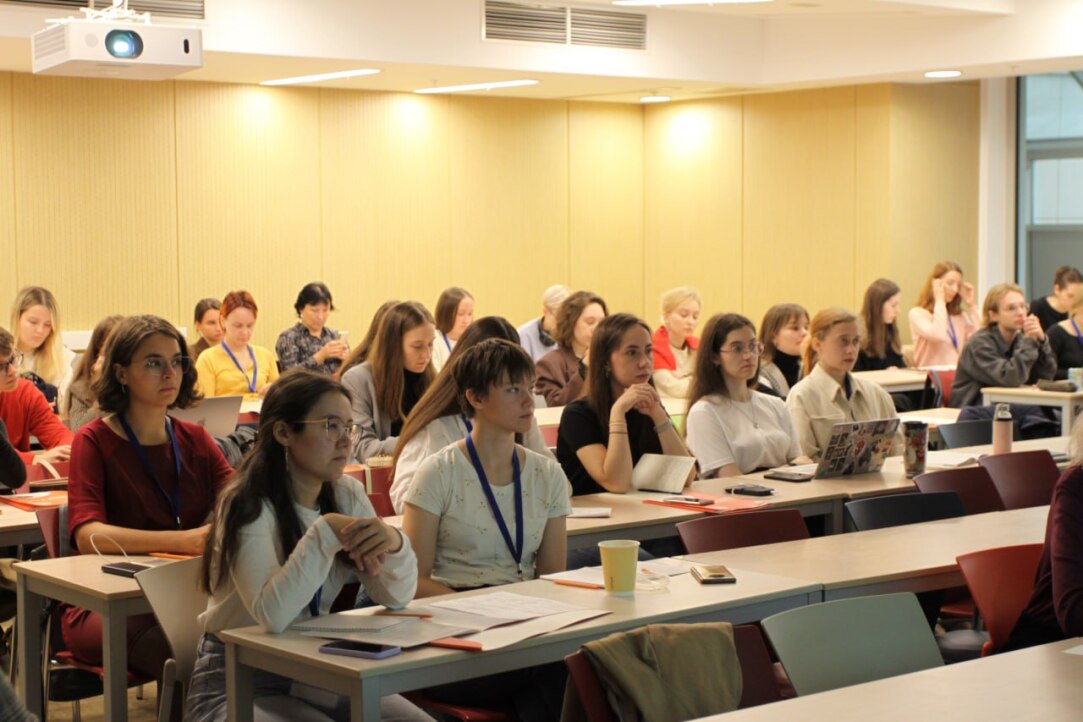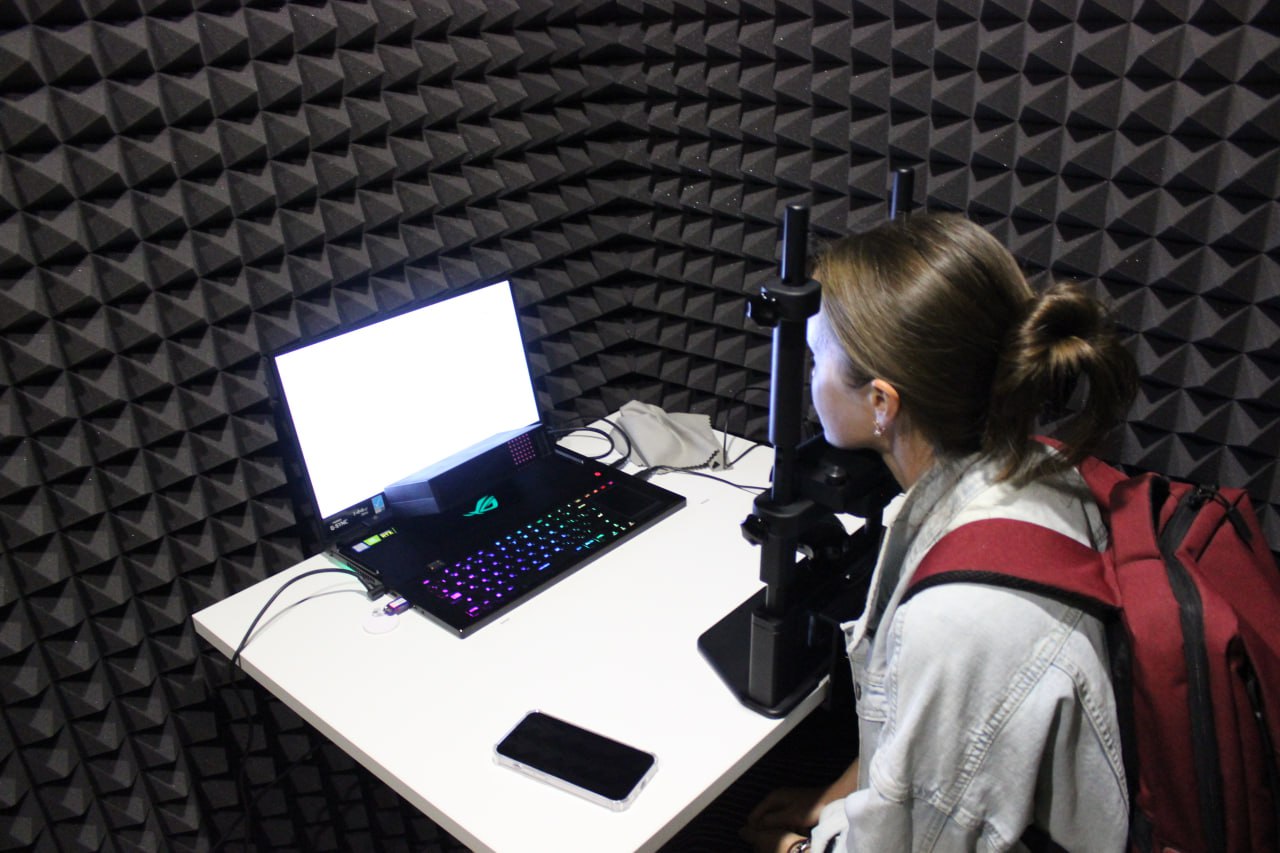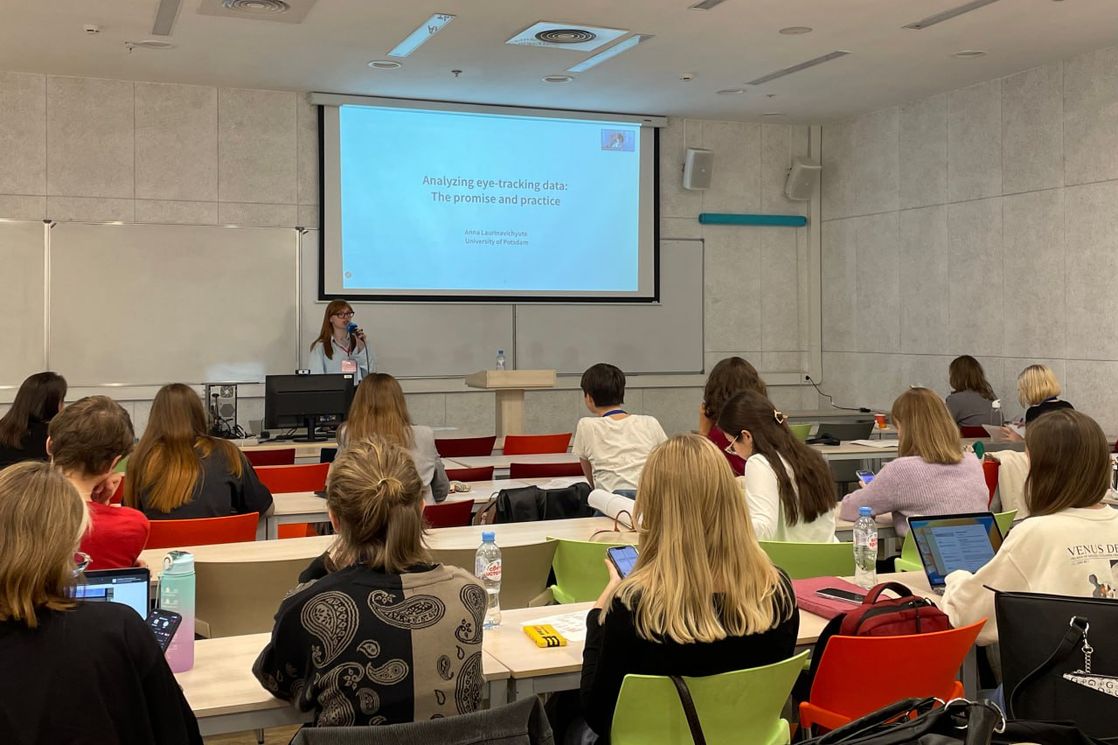HSE University Holds 10th Summer School ‘Eye-tracking in the Lab and Beyond’

This year, more than 100 students from Russia and abroad took part in the 10th summer neurolinguistic school, ‘Eye-tracking in the Lab and Beyond’. The school is held annually by the HSE Center for Language and Brain. Leading experts spoke about advanced developments and research in the field of video-oculography.
Video-oculography, or eye-tracking, is a modern research method that allows scientists to record eye movements using powerful equipment including special portable glasses equipped with video cameras.
HSE Center for Language and Brain is one of the leading Russian scientific organisations engaged in research within the field of video-oculography. Since opening in 2018, the centre has conducted multiple studies with the participation of children and adults, as well as speakers of rare languages, such as Adyghe and Tuyuk. In addition, the centre’s video-oculographic studies have made a great contribution to the study and development of methods for correcting reading problems in children.

Anastasia Lopukhina, researcher at the University of London, presented an overview of recent studies on eye movement during reading in children. Studies have shown that the transparency of spelling affects the speed at which children learn to read. In addition, Anastasia talked about whether TV subtitles in their native language can help children develop their reading skills faster.
Irina Sekerina, a researcher from New York University, spoke about experiments which register eye movements using a webcam. This new methodology gained particular popularity during the COVID-19 pandemic, because it allows scientists to conduct research and collect data online without using expensive equipment. Despite the fact that the methodology has a number of limitations, its accessibility has great potential for conducting psycholinguistic research.
The report of Svetlana Alekseeva, senior researcher at the Institute for Cognitive Studies of St. Petersburg State University, was devoted to the study of eye movements for testing Cyrillic fonts, including the recently developed Cyrillic LexiaD font adapted for people with dyslexia.
On the second day of the school, Anna Izmalkova, research fellow at HSE Centre for Cognition & Decision Making, spoke about eye movement research in the field of visual searches and problem solving strategies. Based on the analysis of eye movement patterns and mistakes made, researchers can conclude what strategy a person uses when learning new words.
Anna Laurinavichyute, a postdoctoral researcher at the University of Potsdam, presented a report on traditional methods of analysing and processing video-oculographic data, as well as on new, more accurate and complex approaches that will improve the quality of video-oculographic research.
The report of Soroosh Shalileh, research fellow at the Center for Language and Brain, head of the Vision Modelling Laboratory, was devoted to the diagnosis of dyslexia based on machine learning and eye movement analysis. This diagnostic method has an advantage over traditional screening, which may require a lot of time and the involvement of highly qualified specialists, so its use should lower the age at which dyslexia is detected.
Representatives of ‘Neuroiconics’ made a presentation ‘From simple to complex. Modern solutions in the field of video-oculography in science, education, medicine and neuromarketing’ and demonstrated modern video oculographs.

During the school, Anna Izmalkova and Tatiana Ledneva, research assistant at HSE Centre for Cognition & Decision Making, held a workshop on working within the ‘Eye Movement Modeling Example’ paradigm. This approach is widely used to improve the efficiency of knowledge transfer during interaction between an expert and a novice in an educational context.
Elena Gorbunova, Head of HSE Laboratory for Cognitive Psychology of Digital Interface Users, spoke about the use of video-oculography in UX research. This method can be used to determine patterns of user behavior — for example, to determine a strategy for finding information or to identify what exactly the user focuses on while working with a particular interface.

‘It is important for us that the participants of the school were able to learn more about the areas of work of the Center for Language and Brain and talk about their research in the field of video-oculography. The great interest in this area confirms its relevance, and together we will make many more important discoveries,’ said Olga Dragoy, director of the Center for Language and Brain.
The school was held with the support of the HSE Human Capital Multidisciplinary Research Centre.
See also:
HSE Researchers Discover Simple and Reliable Way to Understand How People Perceive Taste
A team of scientists from the HSE Centre for Cognition & Decision Making has studied how food flavours affect brain activity, facial muscles, and emotions. Using near-infrared spectroscopy (fNIRS), they demonstrated that pleasant food activates brain areas associated with positive emotions, while neutral food stimulates regions linked to negative emotions and avoidance. This approach offers a simpler way to predict the market success of products and study eating disorders. The study was published in the journal Food Quality and Preference.
HSE Neurolinguists Create Russian Adaptation of Classic Verbal Memory Test
Researchers at the HSE Centre for Language and Brain and Psychiatric Hospital No. 1 Named after N.A. Alexeev have developed a Russian-language adaptation of the Rey Auditory Verbal Learning Test. This classic neuropsychological test evaluates various aspects of auditory verbal memory in adults and is widely used in both clinical diagnostics and research. The study findings have been published in The Clinical Neuropsychologist.
Researchers at HSE Centre for Language and Brain Reveal Key Factors Determining Language Recovery in Patients After Brain Tumour Resection
Alina Minnigulova and Maria Khudyakova at the HSE Centre for Language and Brain have presented the latest research findings on the linguistic and neural mechanisms of language impairments and their progression in patients following neurosurgery. The scientists shared insights gained from over five years of research on the dynamics of language impairment and recovery.
Neuroscientists Reveal Anna Karenina Principle in Brain's Response to Persuasion
A team of researchers at HSE University investigated the neural mechanisms involved in how the brain processes persuasive messages. Using functional MRI, the researchers recorded how the participants' brains reacted to expert arguments about the harmful health effects of sugar consumption. The findings revealed that all unpersuaded individuals' brains responded to the messages in a similar manner, whereas each persuaded individual produced a unique neural response. This suggests that successful persuasive messages influence opinions in a highly individual manner, appearing to find a unique key to each person's brain. The study findings have been published in PNAS.
'We Are Creating the Medicine of the Future'
Dr Gerwin Schalk is a professor at Fudan University in Shanghai and a partner of the HSE Centre for Language and Brain within the framework of the strategic project 'Human Brain Resilience.' Dr Schalk is known as the creator of BCI2000, a non-commercial general-purpose brain-computer interface system. In this interview, he discusses modern neural interfaces, methods for post-stroke rehabilitation, a novel approach to neurosurgery, and shares his vision for the future of neurotechnology.
Smoking Habit Affects Response to False Feedback
A team of scientists at HSE University, in collaboration with the Institute of Higher Nervous Activity and Neurophysiology of the Russian Academy of Sciences, studied how people respond to deception when under stress and cognitive load. The study revealed that smoking habits interfere with performance on cognitive tasks involving memory and attention and impairs a person’s ability to detect deception. The study findings have been published in Frontiers in Neuroscience.
'Neurotechnologies Are Already Helping Individuals with Language Disorders'
On November 4-6, as part of Inventing the Future International Symposium hosted by the National Centre RUSSIA, the HSE Centre for Language and Brain facilitated a discussion titled 'Evolution of the Brain: How Does the World Change Us?' Researchers from the country's leading universities, along with health professionals and neuroscience popularisers, discussed specific aspects of human brain function.
‘Scientists Work to Make This World a Better Place’
Federico Gallo is a Research Fellow at the Centre for Cognition and Decision Making of the HSE Institute for Cognitive Research. In 2023, he won the Award for Special Achievements in Career and Public Life Among Foreign Alumni of HSE University. In this interview, Federico discusses how he entered science and why he chose to stay, and shares a secret to effective protection against cognitive decline in old age.
From Sequencing to Constructing a Cardio Panel: Summer School in Cardiogenetics
From August 19 to 29, the Continuing Professional Development Centre of the HSE Faculty of Computer Science hosted the summer school 'Cardiogenetics: From Sequencing to Constructing a Cardio Panel,' organised in collaboration with the Russian Academy of Sciences' Institute of Analytical Instrumentation (IAI) and Institute of Spectroscopy (ISAN), and the Syntol company. The summer school was conducted within the framework of the Federal Research Programme for Genetic Technologies Development for 2019–2027 (Project 15.IP.21.0004).
'Science Is Akin to Creativity, as It Requires Constantly Generating Ideas'
Olga Buivolova investigates post-stroke language impairments and aims to ensure that scientific breakthroughs reach those who need them. In this interview with the HSE Young Scientists project, she spoke about the unique Russian Aphasia Test and helping people with aphasia, and about her place of power in Skhodnensky district.


